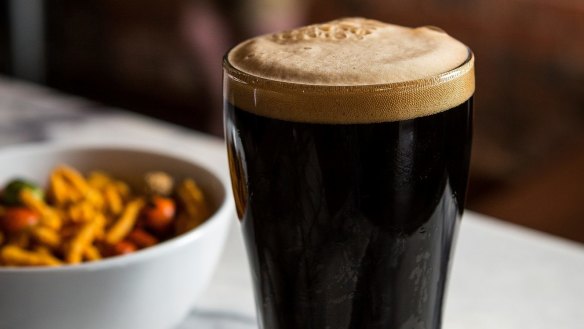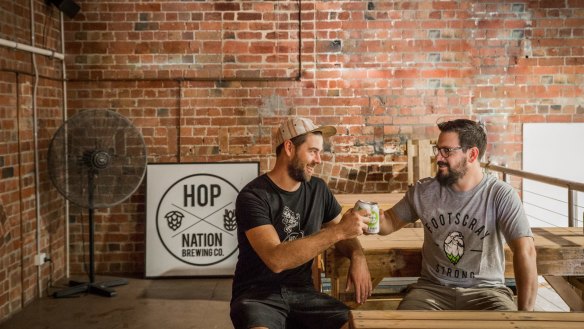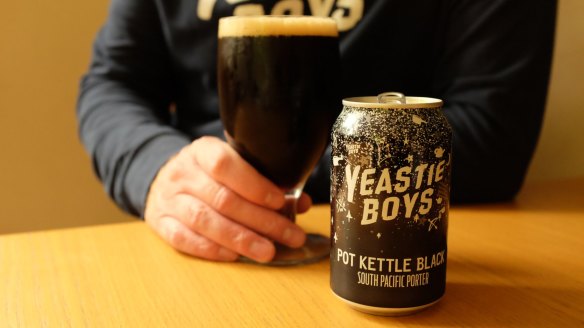Dark charms: The return of stouts, porters and other dark beers

One of Stu McKinley's most cherished moments as a brewer came on a dark night at a Wellington pub. "It was the second time we'd made Pot Kettle Black, our porter, and we were releasing it alongside another dark beer [that had been] made by the New Zealand homebrew champion," the co-owner of Yeastie Boys says. "At one point I looked around and everyone in the place was drinking porter, and I thought: 'I'll probably never see this again'."
He's almost certainly right. Walk into a modern beer bar anywhere in the world, and chances are you'll find a solitary dark beer alongside dozens of exotically named, potently hopped pale ales. Given that the latter have driven the popularity of craft beer, that's understandable – but there does seem to be a growing appreciation of stout and porter, in Australia as much as anywhere else.
Online beer shop Beer Cartel recently released its Ultimate Top 50 Best List – produced by collating results from beer-rating websites and the annual Hottest 100 Aussie Craft Beers list – and, rather surprisingly, stouts were the most represented style, with 16 in the list. A closer look reveals why: most are Imperial Russian Stouts (IRS), the strongest variety, which have long been popular with the more fervent end of the beer-drinking market but which sell in small quantities.

At this time of year, though, brewers and drinkers seem most inclined to give their less alcohol-heavy relatives a chance. A number of new stouts and porters are appearing on bars around the country, such as The Karma, a 5 per cent ABV oatmeal stout from Hop Nation Brewing Company in Footscray. "We see a shift, especially in Melbourne when the weather changes quite dramatically towards the end of May," says co-owner and brewer Sam Hambour. "Pilsner starts to drop off and there's a swing towards stout."
Oatmeal stouts – made with a portion of oats in the mash, giving the beer a silky, easy-drinking texture – are just one of a dizzying variety of dark beer styles (the terms "stout" and "porter" are interchangeable in the modern era, although some brewers insist the former needs roasted barley). Nail Brewing in Bassendean, Western Australia, has been making oatmeal stout since 2002, a sign of owner and head brewer John Stallwood's commitment to dark beer.
"They taste good!" he says. "You can drink them fresh or age them. With a traditional bottle-conditioned Imperial Russian Stout, you can taste the evolution and difference between the years. There's so many ways to make them, so many flavours you can get [from them]."
I like the fact that you can fit so many flavours into a dark beer.
Nail also makes one of the best loved modern Australian stouts, Clout Stout (No. 3 on that Beer Cartel list, the highest for a stout). It's an IRS, first produced in 2010, and released annually in tiny batches: 1000 bottles and a handful of kegs. Brewed with six different malt varieties, it's a rich, complex, rewarding beer that deserves respect, weighing in at about 10 per cent ABV.
"We use four different types of malt – chocolate, crystal, black and pale – plus roasted barley and rolled oats," says Nail. "It's hard to brew, and I don't look forward to hand-bottling it – but I do like drinking it all year round."
McKinley is equally passionate about porter. New Zealand is one of the most receptive markets around for dark beer, a reflection of the craft-beer industry's relative maturity there as much as the weather. Pot Kettle Black makes up about 20 per cent of Yeastie Boys' output across the Tasman. It's much less in demand in Australia, where it's only worth producing during the winter.

"I like the fact that you can fit so many flavours into a dark beer," McKinley says. "You come to expect something from pale beers: they're fresh and crisp. Dark beer has a much broader palate of what it can be. They can be fresh and hoppy, they can be dark and rich and comforting. I see it as a great beer to drink in all seasons, whereas I know a lot of people see it as a winter-season beer."
McKinley says it's not just Australia that struggles to warm to stout. In Britain (where he now lives) it can be difficult to sell dark beer, too, despite the fact that it's the home of these beers – and the weather would seem to be more amenable.
"I love all kinds of beer styles, but if I walk into the pub and see one or two decent dark beers, it's unlikely I'm even going to look at the pale beers," he says. "But in a lot of modern beer bars [in Britain], everything is hoppy or sour so it's a real treat to find a dark beer."
The perception that dark beer doesn't go with warm weather is an odd one given that stout is hugely popular in some warm parts of the world, such as the Caribbean and parts of West Africa, and it has a long tradition in Australia (one that survives in the form of beers such as Abbotsford Invalid Stout and Carlton's Sheaf Stout).
In its dry, often extravagantly hoppy modern form, it can be extremely refreshing, too. "We see stout being drunk in warmer weather," says Hambour, "but there's definitely a stigma that Australians have that it's just for winter. I guess it has that richness that makes it seem more appealing when the weather is cold; it's more of a mental thing than the reality of it tasting better in winter."
Stouts suit the sort of food you might eat when the weather's not up to much: rich, warming stews, for example, or blue cheese, a natural partner for IRS. And oatmeal stout, with its softer mouthfeel, is just the thing on a cold winter's day.
"The Karma has got a lot of flavour, roundness and richness, but it's only 5 per cent alcohol," says Hambour. "It's got that extra bit of flavour and mouthfeel, that drinkability. We've been working with different types of oats on a couple of other beers, and we used those techniques here, too.
"It's a great option for winter when you want to have more than one. There's a lot of people who want to drive, or have a few with their friends at our tasting room, so they'll have a couple of oatmeal stouts. If they have a couple of The Kalash [Hop Nation's IRS at 10.2 per cent ABV], their day will have quickly run its course."
Might stout one day take over from pale ale? Hambour is not holding his breath, but says Oatmeal Stout could be added to Hop Nation's line-up year-round.
"We've been working towards adding a dark beer to our core range – we've tried hoppy porters and brown ales, but this oatmeal stout is leading the race for that at the moment."
That's something to keep stout lovers warm this winter.
Six dark styles to try
Black IPA
Expect tropical hop-character and bitterness rather than roastiness.
Try: Yeastie Boys Pot Kettle Black.
Dry Irish Stout
Roasty, dry and often served using nitrogen to create a creamy consistency.
Try: Guinness.
Imperial Russian Stout
Strong (at least 8 per cent ABV) and varied: it can be roasty and bitter, or soft and smooth. Often barrel-aged.
Try: Nail Clout Stout.
London Porter
Anywhere from dark brown to pitch black in colour, this is restrained and easy-drinking.
Try: Fuller's London Porter.
Milk Stout
Traditionally made with lactose, this stout has residual sweetness. Some versions are very low-alcohol.
Try: Abbotsford Invalid Stout.
Oatmeal Stout
Silky and smooth from the oats used to make it, this can be nutty and roasted too.
Try: Hop Nation The Karma.